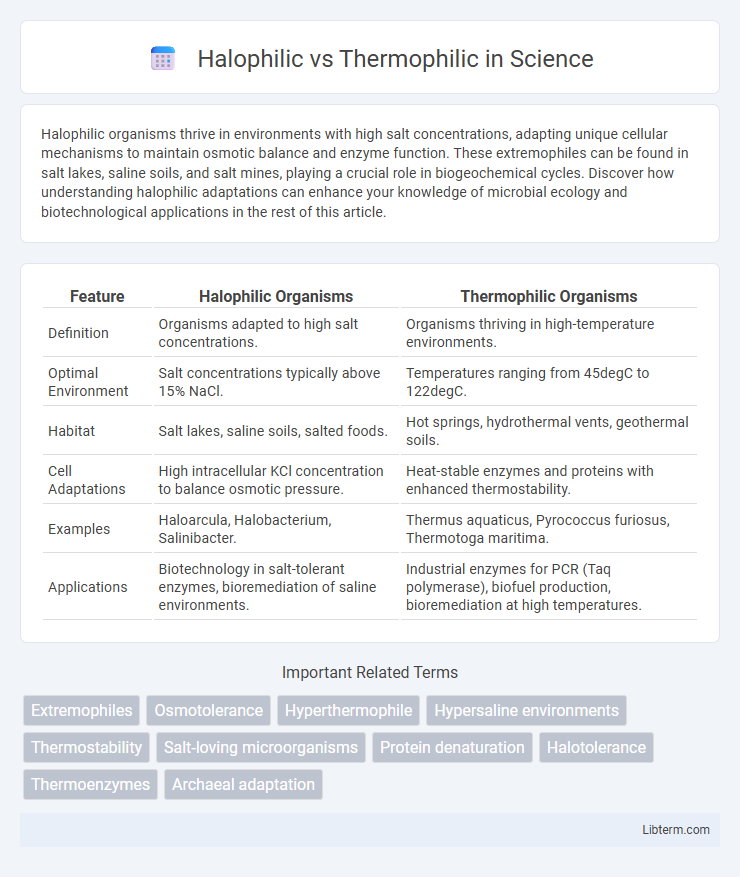Halophilic organisms thrive in environments with high salt concentrations, adapting unique cellular mechanisms to maintain osmotic balance and enzyme function. These extremophiles can be found in salt lakes, saline soils, and salt mines, playing a crucial role in biogeochemical cycles. Discover how understanding halophilic adaptations can enhance your knowledge of microbial ecology and biotechnological applications in the rest of this article.
Table of Comparison
| Feature | Halophilic Organisms | Thermophilic Organisms |
|---|---|---|
| Definition | Organisms adapted to high salt concentrations. | Organisms thriving in high-temperature environments. |
| Optimal Environment | Salt concentrations typically above 15% NaCl. | Temperatures ranging from 45degC to 122degC. |
| Habitat | Salt lakes, saline soils, salted foods. | Hot springs, hydrothermal vents, geothermal soils. |
| Cell Adaptations | High intracellular KCl concentration to balance osmotic pressure. | Heat-stable enzymes and proteins with enhanced thermostability. |
| Examples | Haloarcula, Halobacterium, Salinibacter. | Thermus aquaticus, Pyrococcus furiosus, Thermotoga maritima. |
| Applications | Biotechnology in salt-tolerant enzymes, bioremediation of saline environments. | Industrial enzymes for PCR (Taq polymerase), biofuel production, bioremediation at high temperatures. |
Introduction to Extremophiles
Halophilic organisms thrive in high-salt environments, such as salt flats and saline lakes, by employing specialized cellular mechanisms to maintain osmotic balance. Thermophilic microorganisms inhabit extreme heat conditions, including hot springs and hydrothermal vents, adapting their proteins and enzymes to remain stable and functional at elevated temperatures. Both halophiles and thermophiles exemplify extremophiles, which are organisms adapted to survive and proliferate in environments previously thought inhospitable to life.
Defining Halophiles: Salt-Loving Microorganisms
Halophiles are salt-loving microorganisms that thrive in environments with high salinity, such as salt lakes, saline soils, and salt mines. These extremophiles have specialized cellular mechanisms to maintain osmotic balance and prevent dehydration in hypertonic conditions. Their ability to survive and metabolize in salt concentrations often exceeding 20% NaCl distinguishes them from thermophiles, which instead adapt to high-temperature habitats.
Understanding Thermophiles: Heat-Loving Microbes
Thermophiles thrive in extreme heat environments ranging from 45degC to over 80degC, often inhabiting hot springs and hydrothermal vents. Their cellular proteins and enzymes exhibit remarkable stability and catalytic efficiency at high temperatures, making them valuable in industrial applications like PCR and biofuel production. In contrast to halophiles, which prefer high-salt conditions, thermophiles specifically adapt to thermal stress through unique membrane lipids and heat-shock proteins.
Environmental Niches of Halophiles
Halophiles thrive in hypersaline environments such as salt lakes, salt mines, and saline soils where salt concentrations are significantly higher than seawater, allowing them to maintain osmotic balance and cellular function. These organisms adapt to extreme osmotic stress by accumulating compatible solutes or using specialized ion pumps, enabling survival in environments with salt concentrations ranging from 3% to over 30%. In contrast, thermophiles inhabit high-temperature environments such as hot springs, hydrothermal vents, and geothermal soils, where temperatures typically exceed 45degC, highlighting the distinct ecological niches of halophiles focused on salinity rather than temperature extremes.
Habitats of Thermophilic Organisms
Thermophilic organisms thrive in extreme heat environments such as hot springs, hydrothermal vents, and geothermal soils where temperatures range from 41degC to 122degC. These habitats provide unique conditions rich in minerals and low in competition, enabling the survival of thermophiles. Their specialized enzymes, such as thermostable DNA polymerases, are adapted to maintain functionality under these high-temperature conditions.
Cellular Adaptations in Halophiles
Halophilic organisms exhibit specialized cellular adaptations such as the accumulation of compatible solutes like potassium chloride (KCl) to maintain osmotic balance in high-salt environments. Their cell membranes contain unique lipid compositions rich in ether-linked lipids, enhancing membrane stability under extreme salinity. Protein structures in halophiles show increased surface acidic residues that promote solubility and function in hypersaline conditions.
Survival Mechanisms in Thermophiles
Thermophiles survive extreme heat by stabilizing their proteins and enzymes through increased hydrogen bonding and hydrophobic interactions, ensuring proper folding at high temperatures. Their cell membranes contain saturated fatty acids that maintain integrity and fluidity, preventing denaturation and leakage. DNA stabilization is achieved by specialized proteins such as histone-like proteins and reverse gyrase, which protect genetic material from thermal damage.
Biotechnological Applications of Halophiles
Halophilic microorganisms, thriving in high-salt environments, have unique enzymes and metabolites valuable for biotechnological applications such as bioremediation of saline wastewaters, production of bioactive compounds, and synthesis of stable enzymes for industrial processes under extreme conditions. Unlike thermophiles that are adapted to high temperatures, halophiles exhibit salt tolerance mechanisms that enable their use in the food industry for salt-rich product fermentation and in pharmaceutical industries for producing salt-stable biomolecules. Their ability to maintain function in hyper-saline conditions makes halophiles indispensable for developing bioprocesses in salt-affected environments, where conventional microbes fail.
Industrial Uses of Thermophilic Microorganisms
Thermophilic microorganisms thrive at high temperatures, making them invaluable in industrial processes such as biofuel production, wastewater treatment, and enzyme manufacturing. Their thermostable enzymes, like thermophilic amylases and proteases, enhance reaction rates and reduce contamination risks in biotechnological applications. This thermal resilience underpins efficient large-scale operations in sectors including pharmaceuticals, agriculture, and food processing.
Comparative Analysis: Halophilic vs. Thermophilic Adaptations
Halophilic organisms thrive in extreme salt concentrations by utilizing specialized ion pumps and compatible solutes to maintain osmotic balance and protein stability, while thermophilic organisms endure high temperatures through enhanced protein folding, increased ionic bonding, and heat-shock protein expression. Both adaptations involve unique membrane lipid compositions: halophiles incorporate negatively charged lipids to stabilize cell walls against ionic stress, whereas thermophiles possess saturated, branched-chain lipids to maintain membrane integrity at elevated thermal conditions. Comparative analysis reveals convergent evolutionary strategies focused on molecular stabilization but distinct biochemical pathways tailored to saline versus thermal environments.
Halophilic Infographic

 libterm.com
libterm.com